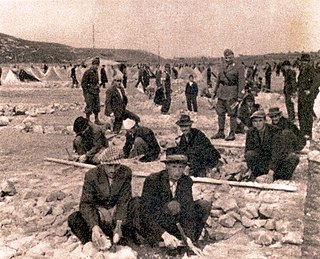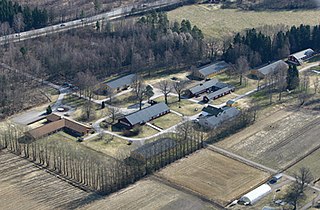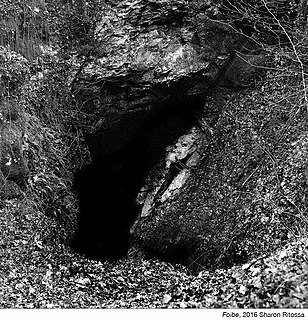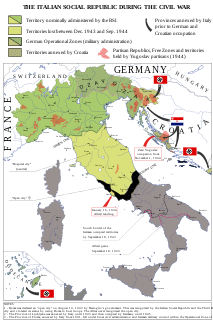
The Rab concentration camp was one of several Italian concentration camps. It was established during World War II, in July 1942, on the Italian-occupied island of Rab.

Italian war crimes have mainly been associated with Fascist Italy in the Pacification of Libya, the Second Italo-Ethiopian War, the Spanish Civil War, and World War II.

Berg interneringsleir was a concentration camp near Tønsberg in Norway that served as an internment and transit center for political prisoners and Jews during the Nazi occupation of Norway.

Numerous internment camps and concentration camps were located in France before, during and after World War II. Beside the camps created during World War I to intern German, Austrian and Ottoman civilian prisoners, the Third Republic (1871–1940) opened various internment camps for the Spanish refugees fleeing the Spanish Civil War (1936–1939). Following the prohibition of the French Communist Party (PCF) by the government of Édouard Daladier, they were used to detain communist political prisoners. The Third Republic also interned German anti-Nazis.

Italianization is the spread of Italian culture, language and identity by way of integration or assimilation.

Bolzano was a transit camp operated by Nazi Germany in Bolzano from 1944 to 3 May 1945 during World War II. It was one of the largest Nazi Lager on Italian soil, along with those of Fossoli, Borgo San Dalmazzo and Trieste.

The foibe massacres, or simply the foibe, refers to mass killings both during and after World War II, mainly committed by Yugoslav Partisans and OZNA, against the local ethnic Italian population, mainly in Julian March, Istria, Kvarner and Dalmatia, against people associated with Fascism, Nazism and collaboration with Axis, and against Croat and Slovene anti-communists. The type of attack was state terrorism and reprisal killings, while ethnic cleansing against Italians is disputed.

Cavalier Angelo Donati was a Jewish Italian banker and philanthropist, and a diplomat of the San Marino Republic in Paris.
Delegation for the Assistance of Jewish Emigrants or DELASEM, was an Italian and Jewish resistance organization that worked in Italy between 1939 and 1947. It is estimated that during World War II, DELASEM was able to distribute more than $1,200,000 in aid, of which nearly $900,000 came from outside Italy.
The Fossoli camp was a concentration camp in Italy, established during World War II and located in the village Fossoli, Carpi, Emilia-Romagna. It began as a prisoner of war camp in 1942, later being a Jewish concentration camp, then a police and transit camp, a labour collection centre for Germany and, finally, a refugee camp, before closing in 1970.

The Monigo concentration camp was a prison camp opened during World War II aimed at civilian prisoners. It was located in Monigo, a suburb of the town of Treviso. The camp was active between 1942 and 1943. The total number of inmates is not certain, but is estimated in a total of around 10,000, with an average number of 2,582 prisoners at a time. The camp often surpassed its full capacity of 2,400.
The internment camp in Casoli, in the province of Chieti, was one of several internment camps set up by the fascist government following the entry of Italy into World War II, to sit foreigners and anti-fascists. It operated from July 1940 to September 1943, with a capacity of 80-90 people. Jewish refugees from Germany and Austria were interned first, then "ex-Yugoslavs".
Nereto, in the province of Teramo, was one of several internment camps set up by the fascist government following the entry of Italy into World War II, to sit foreigners and anti-fascists. It operated from July 1940 to February 1944, with a maximum capacity of 160 people. There were Jewish and Slavic refugees interned from the Balkans in this camp.
Servigliano prison camp began as a POW camp for Austrian soldiers of World War I. Following Italy's entry to World War II, the fascist government used it as a concentration camp for civilian and military prisoners between October 1940 to September 1943. The Italian Social Republic later converted it into a deportation camp for Jews between October 1943 and June 1944.

Pithiviers internment camp during the Holocaust was a transit camp for Jewish deportees in Pithiviers in Occupied France during the Second World War. Children were separated there from their parents; the adults were processed and deported to concentration camps farther away, usually Auschwitz. This was the fate of the novelist Irène Némirovsky.

The Holocaust in Italy was the persecution, deportation, and murder of Jews between 1943 and 1945 in the Italian Social Republic, the part of the Kingdom of Italy occupied by Nazi Germany after the Italian surrender on September 8, 1943, during World War II.

San Vittore is a prison in the city center of Milan, Italy. Its construction started in 1872 and opened on 7 July 1879. The prison has place for 600 inmates, but it had 1036 prisoners in 2017.

Borgo San Dalmazzo was an internment camp operated by Nazi Germany in Borgo San Dalmazzo, Piedmont, Italy.
The RSI Police Order No. 5 was an order issued on 30 November 1943 in the Italian Social Republic to the Italian police in German-occupied northern Italy to arrest all Jews except those born of mixed marriages, which were required to be monitored by the police.
Paolo Zerbino was an Italian Fascist politician, prefect of Split and Turin during World War II and Minister of the Interior of the Italian Social Republic.













